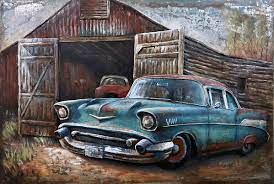Painting, one of the most ancient and revered forms of artistic expression, has captivated the human imagination for millennia. From prehistoric cave schilderij to modern abstract works, this medium has evolved dramatically while continuing to serve as a powerful means of communication and creativity.
The Origins of Painting
The origins of painting can be traced back to prehistoric times. Early humans used natural pigments to create images on cave walls, as seen in the famous Chauvet Cave in France. These early artworks often depicted hunting scenes, animals, and abstract patterns, offering insight into the lives and beliefs of our ancestors. These ancient paintings were not only decorative but also held spiritual and ritual significance.
The Evolution of Painting Techniques
As civilizations developed, so did painting techniques. In ancient Egypt, frescoes and wall paintings adorned tombs and temples, showcasing intricate details and vibrant colors. The Greeks and Romans further refined painting methods, incorporating perspective and anatomy to create more lifelike representations.
During the Renaissance, painting underwent a profound transformation. Artists such as Leonardo da Vinci, Michelangelo, and Raphael embraced realism and perspective, leading to masterpieces that captured the human form and the natural world with unprecedented accuracy. The use of oil paint, developed during this period, allowed for richer colors and more detailed textures, setting the stage for future innovation.
The Baroque era followed, characterized by dramatic contrasts of light and shadow and emotional intensity. Artists like Caravaggio and Rembrandt pushed the boundaries of painting, exploring themes of human experience and the divine with compelling realism.
The Modern Era and Beyond
The 19th and 20th centuries witnessed a revolution in painting styles and techniques. Impressionism, pioneered by Claude Monet and Pierre-Auguste Renoir, shifted focus from detailed realism to capturing the effects of light and color. This movement laid the groundwork for subsequent styles such as Post-Impressionism, Cubism, and Abstract Expressionism.
In the contemporary era, painting continues to evolve. Artists experiment with new materials, techniques, and concepts, often blurring the boundaries between painting and other art forms. Digital technology has also opened new avenues for artistic expression, allowing for innovative approaches to both traditional and non-traditional painting practices.
The Significance of Painting Today
Painting remains a vital form of artistic expression, offering a means to explore personal and societal themes. It serves as a powerful medium for commentary, self-expression, and cultural preservation. Whether through classical techniques or cutting-edge innovations, painting captures the complexities of the human experience and continues to inspire and provoke thought.
In an ever-changing world, painting endures as a testament to human creativity and resilience. It invites viewers to see the world through the artist’s eyes and to appreciate the beauty and complexity of life in all its forms.


